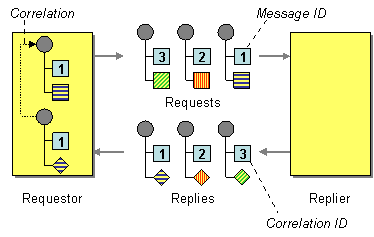Overview
The correlation identifier pattern, shown in Figure 6.1, “Correlation Identifier Pattern”, describes how to match reply messages with request messages, given that an asynchronous messaging system is used to implement a request-reply protocol. The essence of this idea is that request messages should be generated with a unique token, the request ID, that identifies the request message and reply messages should include a token, the correlation ID, that contains the matching request ID.
Apache Camel supports the Correlation Identifier from the EIP patterns by getting or setting a header on a Message.
When working with the ActiveMQ or JMS components, the correlation identifier header is called JMSCorrelationID. You can add your own correlation identifier to any message exchange to help correlate messages together in a single conversation (or business process).
A correlation identifier is usually stored in a Apache Camel message header.
Some EIP patterns spin off a sub message and, in those cases, Apache Camel adds a correlation ID to the Exchange as a property with they key, Exchange.CORRELATION_ID, which links back to the source Exchange. For example, the Splitter, Multicast, Recipient List, and Wire Tap EIPs do this.
Figure 6.1. Correlation Identifier Pattern








 本文介绍了一种用于异步消息系统中请求-响应协议的消息关联标识模式。该模式通过为请求消息分配唯一请求ID,并在响应消息中包含对应请求ID的关联ID来确保消息间的正确关联。Apache Camel 支持此模式并通过消息头进行标识。
本文介绍了一种用于异步消息系统中请求-响应协议的消息关联标识模式。该模式通过为请求消息分配唯一请求ID,并在响应消息中包含对应请求ID的关联ID来确保消息间的正确关联。Apache Camel 支持此模式并通过消息头进行标识。

















 27
27

 被折叠的 条评论
为什么被折叠?
被折叠的 条评论
为什么被折叠?








